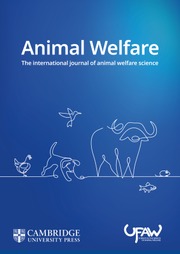Article contents
Is the response to humans consistent over productive life in dairy cows?
Published online by Cambridge University Press: 01 January 2023
Abstract
Dairy cattle have a high level of interaction with humans throughout their productive life. Welfare and productivity are affected if cows find these interactions aversive, so tests assessing fear of humans have been included in welfare assessment protocols. Practicality issues suggest that all animals on large farms cannot be tested. If a sub-sample is chosen, then animal factors affecting the response must be investigated. To assess the effect of age, 114 Holstein cows were tested at regular intervals across their productive lifetime. Animals were tested at 12-15 months of age, first breeding, prior to first calving, then at early, mid and late lactation for 1st and 2nd lactations and into their 3rd lactation. The test involved approaching each cow when standing in the passageway of the barn with sufficient space to retreat. Response was recorded on a 0-8 incremental scale, and several qualitative terms were scored using sliding scales from absence to full presence. There was a significant effect of age on response. Cows became more approachable with increasing age, up until the middle of the first lactation, with no further change beyond this stage. Cows became more at ease and less nervous with increasing age. Individual cow within-group rankings for tests at each stage showed correlation with rankings in the following stage. As this is a single-farm study, further research is necessary to assess interaction of factors such as housing, breed and quality of human handling on the long-term development of fear of humans. However, the results suggest that the age of the animal tested affects the response, and that animals of different age groups should be tested when a sub-sampling is required to assess welfare on large farms.
Information
- Type
- Research Article
- Information
- Animal Welfare , Volume 21 , Issue 3: Selected papers from the 5th International Workshop on the Assessment of Animal Welfare at Farm and Group Level , August 2012 , pp. 319 - 324
- Copyright
- © 2012 Universities Federation for Animal Welfare
References
- 8
- Cited by

